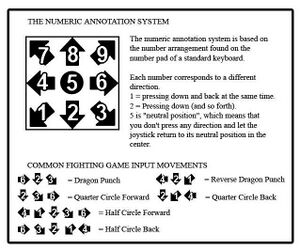| Virtua Fighter 3tb (VF3tb) | |
|---|---|
| Developers |
SEGA AM2 |
| Publishers |
SEGA |
| Systems |
Arcade (Model 3) |
| Dreamcast | |
| Online Play |
Rollback (via Fightcade 2) |
| Community Channels | |
| virtuafighter.com | |
Virtua Fighter 3 Team Battle is a 3D fighting game developed by Sega AM2 in 1997. It is the update to Virtua Fighter 3, and is the currently played competitive version of VF3. Advanced graphically for its time, Virtua Fighter 3tb would take a full year before coming to the Sega Dreamcast in 1998 in Japan and 1999 in other territories. This entry in the Virtua Fighter series is noted for featuring an additional escape button compared to the normal 3-button layout traditional to the rest of the series. It is also praised for its deep movement and great balance.
Controls
Buttons
P K E ← STANDARD ARCADE BUTTON LAYOUT G P = Punch K = Kick E = Evade G = Guard
Numpad Notation for Directional Inputs
The Virtua Fighter community uses the numpad notation system to describe directional inputs.
Game Mechanics
Attack Levels
Similar to other 3d fighters, there are 3 levels of attacks in VF3tb.
High attacks can be blocked while standing, and will whiff over crouching opponents.
Mid attacks can be blocked while standing and will hit crouching opponents.
Low attacks can be blocked while crouching, and will hit standing opponents.
(EX-Mid attacks will connect with crouching opponents and force them standing, but will not do damage to them.)
Throws
Throws will connect with standing opponents, but will whiff on crouching opponents.
Low throws will connect with crouching opponents, but will whiff on standing opponents.
Throws can be escaped with P+G and the direction of the command throw within 10 frames of the throw connecting. Throws with half circle inputs need to be escaped with the first and last direction of the throw. (E.g, Wolf's Giant Swing needs to be escaped with 46p+g.)
Catch Throws cannot be escaped.
Throws have a lockout period after an attack connects with an opponent where neither player can throw. This last 8 frames after an attack is guarded, 9 frames if an attack connects on normal hit, and -1 frame on counter hit.
RPS System
Virtua Fighter uses a Rock/Paper/Scissors system to determine who wins exchanges. In Virtua Fighter, attacks beat throws, throws beat guard, and guard will beat attacks. What does this mean? Well, if your opponent's attack is in startup, they are completely throw invulnerable. It doesn't matter how slow your opponent's move is, you absolutely cannot throw them. When can you throw your opponents? anytime they are not attacking. If they stand guard, evade, dash, or are in the process of crouch blocking(before they are fully crouched) you can throw them. Guard will beat attacks by giving you advantage when blocking most moves. There are exceptions to the rules(guard breaks for example), but the RPS system is mostly consistent and a staple of the VF series.
OTG
There are a number of different ways in which you can end up on the ground. You can either get knocked down by your opponent's attack or throw, or even your own attack which may leave you recovering on the ground. While you are laying prone on the ground, you have a number of options to choose from in deciding how to rise. You can either rise in place, after a side roll, back roll or forward roll. Additionally, you can choose to perform either a mid or low level a rising attack.
The constant factor with all rising techniques is that once you're knocked down on the ground, there's a set amount of time that you'll be stunned for and unable to move. You can reduce this amount of stun time by rapidly entering any Joystick/Button inputs, enabling you to rise much quicker.
After rolling, you can choose to wake-up crouching by holding 2. You can choose to do this and instantly preform a stand block afterwards, essentially fuzzy guarding
Rising Attacks are dependent on your initial knock down position, and whether you choose to rise in place, with a side roll, forward roll, or back roll. In general, mid rising attacks are throw/jab punishable on block, and low wakeup kicks are elbow/low throw punishable. Rising attacks can be heavily delayed. Choosing to delay your wake-up kick can mess with your opponents timing. Mid-class rising attacks usually stagger on hit, meaning you get more reward for it than low rising attacks.
You can also rise with a handstand by pressing evade. This is useful for escaping your opponents down attacks and certain okizeme setups.
Stagger
An attack that puts the opponent off their balance, causing them to take a few small steps backward, and doesn't knock them down. While the opponent is staggered they are unable to guard, but will be invulnerable to throws. The amount of time spent in the stagger can be reduced by struggling. The most common type of stagger is crouch stagger which happens when certain mid attacks (conventional 6p or 3k for example) connect with crouching opponents.
Struggling is a term used to describe entering many inputs with the joystick and buttons in a short amount of time, for the purposes of reducing the time spent in vulnerable state. A struggle technique commonly used is to hold G while circling the joystick and simultaneous alternating the P and K buttons. This sends many inputs in a short period of time while ensuring that you're maintaining a Guard the moment you recover.
Evade
The Evade button will move you into the foreground or background depending on if you press down or keep the stick on neutral. Evade will make many attacks whiff, and can be cancelled with commands, creating many punishment opportunities. Evade can also be cancelled with crouch dash, meaning you don't have to do a command to cancel evade, and can act more freely.

